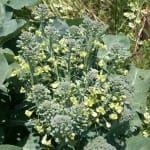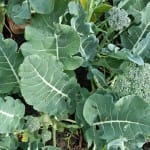Source(s): Walter Reeves, College of Agricultural and Environmental Sciences, Former County Extension Agent – DeKalb County
One of the fastest growing vegetables (in popularity, that is) in recent years has been broccoli. Although this delectable food has been farmed for many years, it has only recently become popular in the American diet. Much of this can probably be attributed to its use on salad bars in restaurants, which has exposed many people to broccoli for the first time.
Whether eaten raw, cooked with cheese sauce over the top, or in a tasty soup, this vegetable is not only good, but is also quite healthy.
Studies in recent years have shown that vegetables from the Brassica family have potential to prevent some cancers. This has caused an increase in broccoli consumption, as well as other leafy greens.
While it may not be for everyone, broccoli is easy to grow and prepare. Of course, there are those like former President George Bush who just won’t eat the stuff no matter how good it is for them.
Broccoli, Brassica oleracea L.var. italica, has been around since Roman times, but was not heard of in America until the early 1800s.
A close relative of cauliflower as well as other cole crops such as cabbage, collards and Brussels sprouts, the type of broccoli most popular in the United States is the Italian green type.
It is generally believed to have originated in the eastern Mediterranean and southern European area.
Broccoli is a cool-season crop and will not fare well in Georgia’s mid-summer heat. But fall and spring crops are commonly produced.
Broccoli is best grown from transplants, although direct seeding is also possible. Consider head size, yield, color, bead size and uniformity and doming when.choosing a variety. Most people prefer varieties with small beads and dark green to blue-green heads. Start seeds five to six weeks before the transplanting date. You can grow them in a seedbed or in small pots or recycled plastic cell-packs. Container-grown transplants are preferable over bare-root plants.
Delay transplanting until most chance for a major freeze has passed. The major production problems associated with broccoli are buttoning, the production of small, undesirable heads, and bolting, the production of a flower head prior to maturity. Keeping the plant healthy and growing is the best prevention for both of these. Stresses of any sort can result in increased buttoning and bolting.
Till the garden properly and apply lime to raise the pH to 6.0-6.5. Fertilize according to soil test recommendations. Apply one- third of the required potassium and nitrogen before planting and the rest in equal applications four and seven weeks after transplanting. Space plants 8-10 inches apart in the row, and space rows three feet apart. Spring transplanting is best: from February 15- March 30. Fall transplanting can be done from August 1-September 20 in south Georgia. More northern areas will have to transplant later in the spring and earlier in the fall.
Keep the crop well-watered and free from stress. Disease, weed and insect control are also important.
Check with your county Extension office for latest recommendations on these practices.
Resource(s): Vegetable Gardening in Georgia
- Growing Gourds - September 24, 2013
- Growing Broccoli - September 24, 2013
- Landscape Drainage Problems - September 24, 2013






